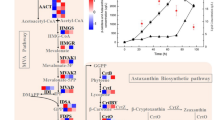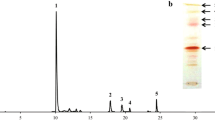Abstract
Unlike the wild type, the mutant Aspergillus carbonarius synthesized a yellow pigment, partially saturated canthaxanthin (PSC) when the growth medium acidified to low pH. Since the pigment found pharmaceutical applications, the possible mechanism involved in its ability to grow at extreme acidic conditions is described. To understand the mutation in the pathway, specific inhibitors affecting carotenoid biosynthesis were used in the medium and PSC synthesis and cell integrity were studied. Results suggested that the possible occurrence of mutation in the isoprenoid pathway for higher production of carotenoid as well as ergosterol caused the mutant to grow in extremely acidic conditions. The results also suggested that the flow of carbon for sterol biosynthesis and that of carotenoids are dependent. The deposition of carotenoids and ergosterol in the cell membrane causing the cells to maintain pH homeostasis under the acidic growth conditions is of significant importance. In A. carbonarius, understanding the cause of stress induced PSC accumulation is essential for efficient expression and production of the pharmaceutically significant carotenoid and this will further facilitate research into the role of carotenoids in stress tolerance of other filamentous fungi.
Similar content being viewed by others
References
Albers, S., van de Vossenberg, J.L.C.M., Driessen, A.J.M., and Konings, W.N., Bioenergetics and solute uptake under extreme conditions, Extremophiles, 2001, vol. 5, pp. 285–294.
AOAC, Official Methods of Analysis, 13th ed., Washington: Association of Official Analytical Chemists, 1980.
Avery, S., Stratford, M., and Van West, P., Stress in Yeasts and Filamentous Fungi, Academic, 2007.
Baatout, S., Leys, N., Hendrickx, L., Dams, A., and Mergeay, M., Physiological changes induced in bacteria following pH stress as a model for space research, Acta Astronaut., 2007, vol. 60, no. 4, pp. 451–459.
Baker-Austin, C. and Dopson, M., Life in acid: pH homeostasis in acidophiles, Trends Microbiol., 2007, vol. 15, no. 4, pp. 165–171.
Bayram, Ö. and Braus, G.H., Coordination of secondary metabolism and development in fungi: the velvet family of regulatory proteins, FEMS Microbiol. Rev., 2012, vol. 36, no. 1, pp. 1–24.
Beales, N., Adaptation of microorganisms to cold temperatures, weak acid preservatives, low pH, and osmotic stress: a review, Compr. Rev. Food Sci. Food Saf., 2004, vol. 3, no. 1, pp. 1–20.
Beney, L. and Gervais, P., Influence of the fluidity of the membrane on the response of microorganisms to environmental stresses, Appl. Microbiol. Biotechnol., 2001, vol. 57, no. 1, pp. 34–42.
Bhosale, P., Environmental and cultural stimulants in the production of carotenoids from microorganisms, Appl. Microbiol. Biotechnol., 2004, vol. 63, no. 4, pp. 351–361.
Bignell, E., The molecular basis of pH sensing, signaling, and homeostasis in fungi, Adv. Appl. Microbiol., 2012, vol. 79, p. 1.
Boor, K.J., Bacterial stress responses: what doesn’t kill them can make them stronger, PLoS Biol., 2006, vol. 4, no.1, p. e23.
Booth, I.R., Cash, P., and O’Byrne, C., Sensing and adapting to acid stress, Antonie van Leeuwenhoek, 2002, vol. 81, no. 1, pp. 33–42.
Britton, G., Overview of carotenoid biosynthesis, Carotenoids, 1998, vol. 3, pp. 13–147.
Claret, S., Gatti, X., Doignon, F., Thoraval, D., and Crouzet, M., The Rgd1p Rho GTPase-activating protein and the Mid2p cell wall sensor are required at low pH for protein kinase C pathway activation and cell survival in Saccharomyces cerevisiae, Eukaryotic Cell, 2005, vol. 4, no. 8, pp. 1375–1386.
Daum, G., Lees, N.D., Bard, M., and Dickson, R., Biochemistry, cell biology and molecular biology of lipids of Saccharomyces cerevisiae, Yeast, 1998, vol. 14, no. 16, pp. 1471–1510.
Echavarri-Erasun, C. and Johnson, E.A., Fungal carotenoids, Appl. Mycol. Biotechnol., 2002, vol. 2, pp. 45–85.
Fritz, G., Koller, C., Burdack, K., Tetsch, L., Haneburger, I., Jung, K., and Gerland, U., Induction kinetics of a conditional pH stress response system in Escherichia coli, J. Mol. Biol., 2009, vol. 393, no. 2, pp. 272–286.
Galhardo, R.S., Hastings, P, and Rosenberg, S.M., Mutation as a stress response and the regulation of evolvability, Crit. Rev Biochem. Mol., 2007, vol. 42, no. 5, pp. 399–435.
Gao, H. and Tan, T., Fed-batch fermentation for ergosterol production, Process Biochem., 2003, vol. 39, no. 3, pp. 345–350.
Gruszecki, W.I. and Strzalka, K., Carotenoids as modulators of lipid membrane physical properties, Biochim. Biophys. Acta, 2005, vol. 1740, no. 2, pp. 108–115.
Haines, T.H., Do sterols reduce proton and sodium leaks through lipid bilayers?, Prog. Lipid Res., 2001, vol. 40, no. 4, pp. 299–324.
Hesse, S.J., Ruijter, G.J., Dijkema, C., and Visser, J., Intracellular pH homeostasis in the filamentous fungus Aspergillus niger, Eur. J. Biochem., 2002, vol. 269, no. 14, pp. 3485–3494.
Hincha, D.K. and Hagemann, M., Stabilization of model membranes during drying by compatible solutes involved in the stress tolerance of plants and microorganisms, Biochem. J., 2004, vol. 383, no. 2, pp. 277–283.
Kumar, A., Srikanta, A.H., Muthukumar, S., Sukumaran, U.K., and Govindaswamy, V., Antioxidant and lipid peroxidation activities in rats fed with Aspergillus carbonarius carotenoid, Food Chem. Toxicol., 2011, vol. 49, no. 12, pp. 3098–3103.
Kumaresan, N., Sanjay, K.R., Venkatesh, K.S., Ravi-Kumar, K., Vijayalakshmi, G., and Umesh-Kumar, S., Partially saturated canthaxanthin purified from Aspergillus carbonarius induces apoptosis in prostate cancer cell line, Appl. Microbiol. Biotechnol., 2008, vol. 80, no. 3, pp. 467–473.
Mantzouridou, F., Naziri, E., and Tsimidou, M.Z., Squalene versus ergosterol formation using Saccharomyces cerevisiae: combined effect of oxygen supply, inoculum size, and fermentation time on yield and selectivity of the bioprocess, J. Agric. Food Chem., 2009, vol. 57, no. 14, pp. 6189–6198.
Mysyakina, I. and Funtikova, N., The role of sterols in morphogenetic processes and dimorphism in fungi, Microbiology (Moscow), 2007, vol. 76, no. 1, pp. 1–13.
Nikolaev, Y.A., Mulyukin, A., and Stepanenko, I.Y., Autoregulation of stress response in microorganisms, Microbiology (Moscow), 2006, vol. 75, no. 4, pp. 420–426.
Scherlach, K. and Hertweck, C., Triggering cryptic natural product biosynthesis in microorganisms, Org. Biomol. Chem., 2009, vol. 7, no. 9, pp. 1753–1760.
Selvig, K. and Alspaugh, J.A., pH response pathways in fungi: adapting to host-derived and environmental signals, Mycobiology, 2011, vol. 39, no. 4, pp. 249–256.
Shimada, H., Kondo, K., Fraser, P.D., Miura, Y., Saito, T., and Misawa, N., Increased carotenoid production by the food yeast Candida utilis through metabolic engineering of the isoprenoid pathway, Appl. Environ. Microbiol., 1998, vol. 64, no. 7, pp. 2676–2680.
Shrestha, B., Han, S.K., Yoon, K.S., and Sung, J.M., Morphological characteristics of conidiogenesis in Cordyceps militaris, Mycobiology, 2005, vol. 33, no. 2, pp. 69–76.
Socaciu, C., Bojarski, P., Aberle, L., and Diehl, H.A., Different ways to insert carotenoids into liposomes affect structure and dynamics of the bilayer differently., Biophys. Chem., 2002, vol. 99, no. 1, pp. 1–15.
Wisniewska, A. and Subczynski, W.K., Effects of polar carotenoids on the shape of the hydrophobic barrier of phospholipid bilayers, Biochim. Biophys. Acta, 1998, vol. 1368, no. 2, pp. 235–246.
Author information
Authors and Affiliations
Corresponding author
Additional information
The article is published in the original.
Rights and permissions
About this article
Cite this article
Kumar, A., Mathimaran, A., Shrikanta, A.H. et al. Role of Partially Saturated Canthaxanthin and Ergosterol in the Survival of Aspergillus carbonarius Mutant at Extreme Acidic Condition. Microbiology 87, 183–190 (2018). https://doi.org/10.1134/S0026261718020066
Received:
Published:
Issue Date:
DOI: https://doi.org/10.1134/S0026261718020066




